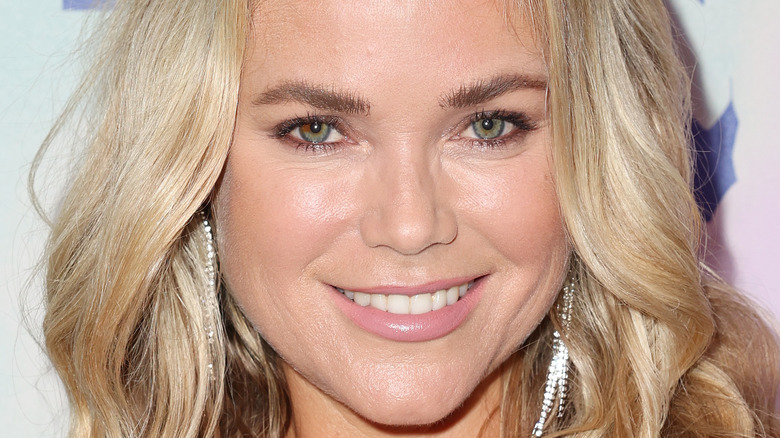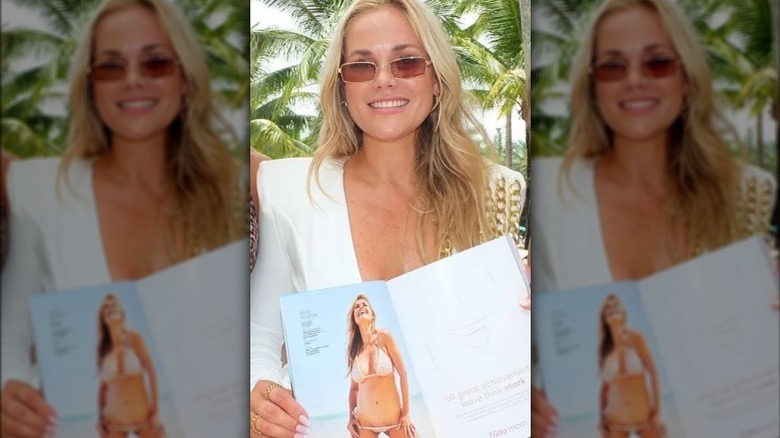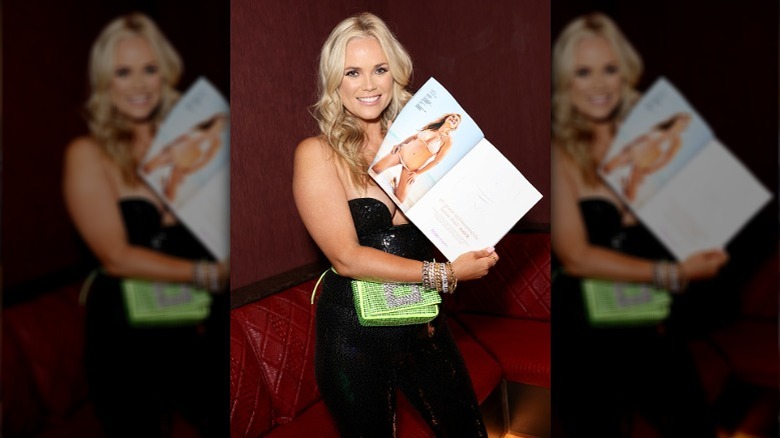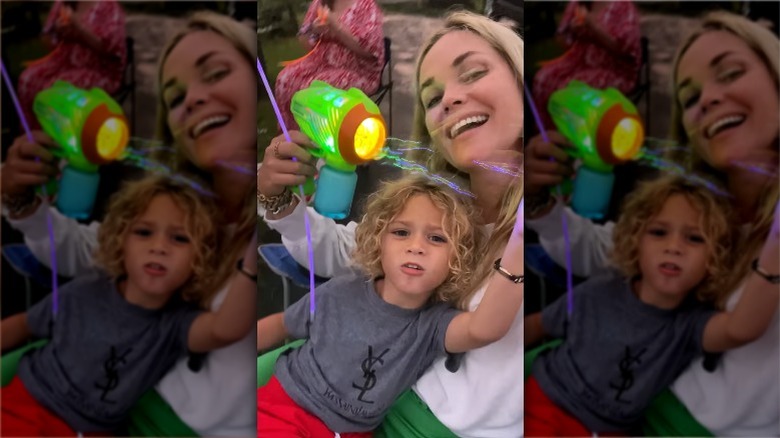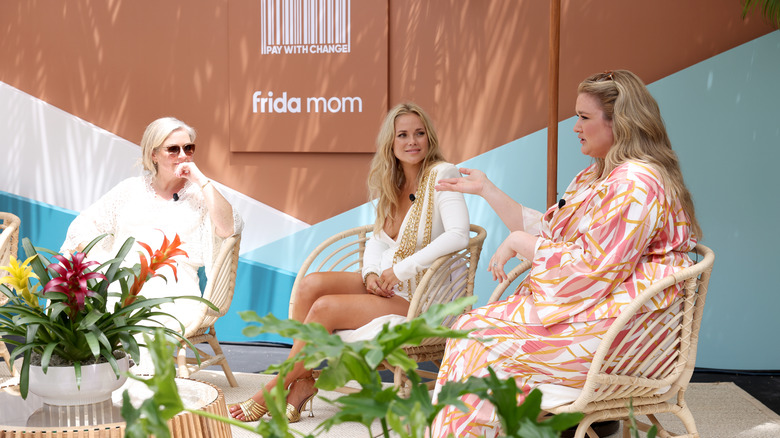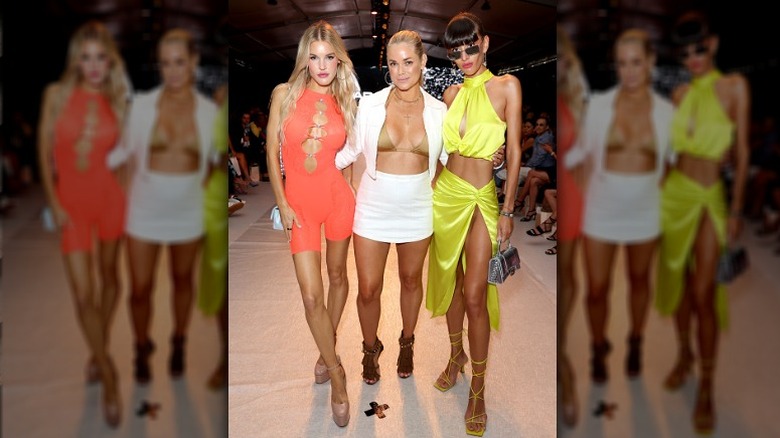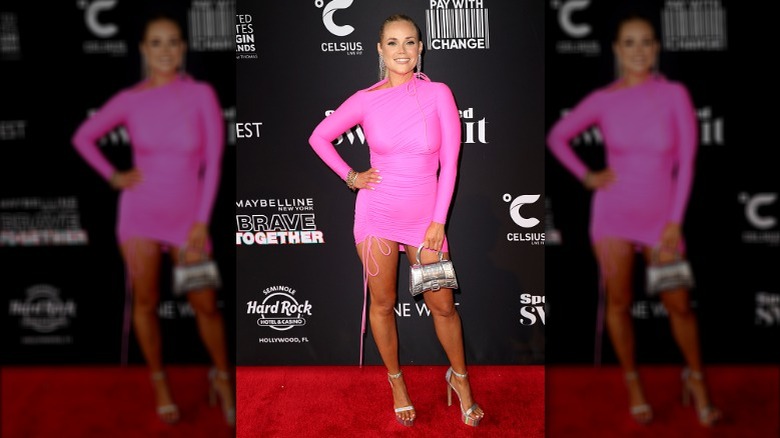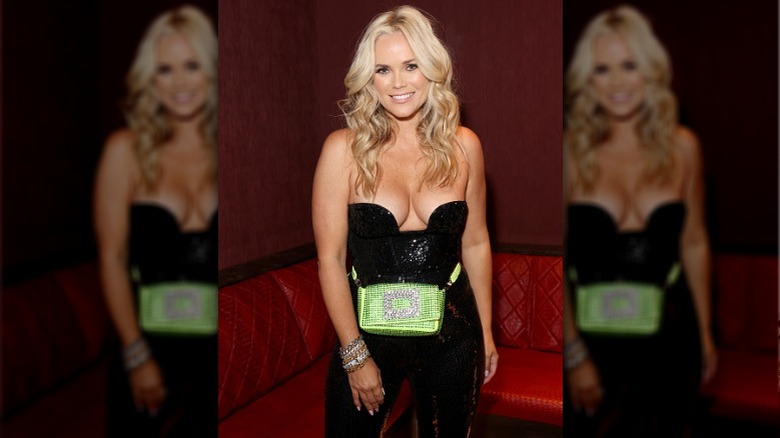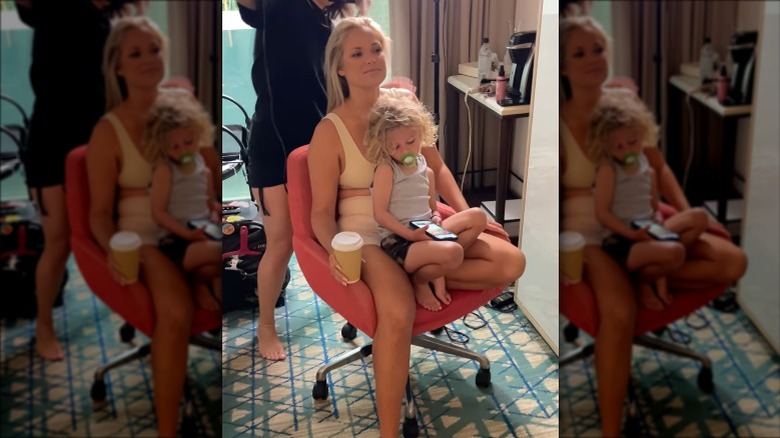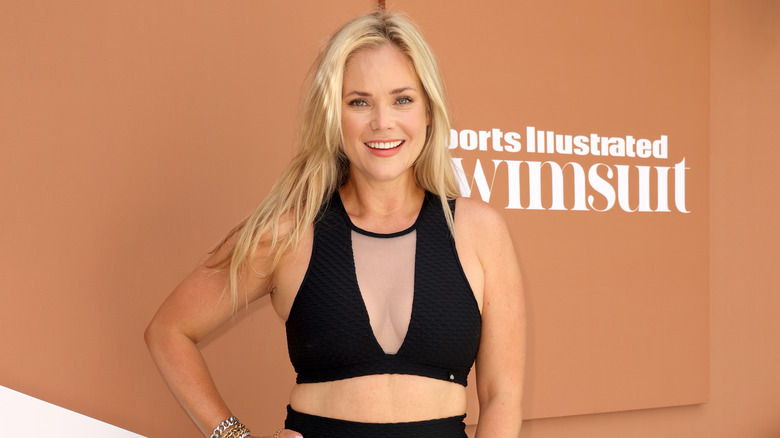Kelly Hughes On Sports Illustrated History, Post-Childbirth Health, And More - Exclusive Interview
Kelly Hughes, who's worked as a professional model for over 20 years, has made Sports Illustrated history as the first swimsuit model to feature her C-section scar. The childbirth procedure in which a baby is delivered via the abdomen, per the American College of Obstetrics and Gynecologists, can be either planned or undertaken as an emergency measure in complicated or risky labor situations. With over 1.1 million babies born via C-section each year in the U.S. alone, equating to about one-third of all U.S. births, according to the Centers for Disease Control and Prevention, it's become extremely common, and unfortunately stigmatized as well.
For Hughes, who had originally planned for a natural childbirth before welcoming her son in 2018, it's a completely unexpected twist of fate that led to her revealing her personal journey and empowering other women to open up about their own experiences and embrace their post-partum bodies. The List had the opportunity to sit down with the Miami-based model, mom, jewelry designer, and entrepreneur upon the publication of the 2022 Sports Illustrated Swimsuit Edition, in which she is featured. We spoke to her about breaking barriers for women, undergoing a scary post-childbirth experience, and more.
Breaking barriers for women
First off, congratulations on becoming Sports Illustrated's first-ever model to feature your C-section scar. It's really a great message you're sending to women regarding body positivity and embracing our flaws. How does that feel?
It's so amazing. Thank you. I've been doing photo shoots for over 20 years. I've been in this business for a long time, and when you do something like this, it's so different than any other photo shoot, because this is an impactful thing that means a lot to people. It resonates so much more than a pretty picture in a magazine, and it has such a big meaning.
[Considering] the fact that this is really underrepresented and hasn't been shown before, I think that at this point, society is becoming more aware. They're more awake about the things that need to be represented. When the pictures came out, I didn't even realize that it was the first time it had been shown, and I didn't realize the impact that it would have, because I am a C-section mom.
The C-section — if you know my birth story, which I was very open with — wasn't my choice of delivery. I was very undereducated on C-sections in general. I was very educated on natural birthing, and I took a lot of time on that, but I wasn't planning on the C-section. In the end, I feel like it's definitely not as talked about as it should be. It's underrepresented. I had no idea the impact that it would have, but the fact that one in three women is now having a C-section is something that needs to be talked about.
Revealing her post-childbirth health scare
I'd love to hear more about your postpartum experience. I'm not a mom yet myself, but I've been trying to become one for four years. It's been a difficult process. What you've experienced sounds like it was incredibly scary, but I'm sure well worth it in the end.
I had a pretty decent pregnancy as far as the general pregnancy. I got nauseous and all that, but I didn't have any other preeclampsia or all these other things that can happen during pregnancy. As far as after the pregnancy was concerned, when I went in to deliver, I thought everything was going to go perfectly fine, especially since I didn't have anything that I should be alarmed about.
Unfortunately, at the last visit right before I gave birth, my son was a lot higher than expected. When the babies are higher, it takes them longer to drop, which means a longer delivery, which means potential to go into problems, because time is of the essence once you start going into the delivery or the labor process.
When I ended up in a C-section, I knew, and the reason why I didn't want a C-section was because the recovery process is definitely longer. In my case, I had a difficult C-section because I ended up with an infection as well. I had to go back to the hospital. I was there eight days, and needed another surgery to remove the infection.
All of this created a [much] harder postpartum for me. It wasn't just physical; it was also mental. I've realized that women struggle in general for so many things after having a baby. Some people are physically fine, but mentally, they're struggling with all the changes, lack of sleep, and the hormones. It's a huge change in the household. Some people have family members come help, and then that can be chaotic.
It's a ton of changes. We all go through something, but in my case, it was mental and physical. I was concerned about getting back to work. I was concerned about my health. I was concerned about all these factors, and that brought on a lot of stress, which then, in turn, made me very insecure. It affected me mentally, affected my recovery process. Thankfully, through that process, my son was so healthy from birth on. He never had any issues. He wasn't colicky, he wasn't difficult. He was such an easy baby.
A friend of mine even joked around — she's like, "You're so lucky you have an easy baby, because with everything you're dealing with, if you would've had that, too, it would've been really, really hard." I kept seeing where I was very fortunate, despite all the chaos and despite everything I was going through. I actually preferred it was me dealing with it than him.
I was so happy he was healthy, and he was truly my strength in it because I had to get better to take care of him. The sooner that I got stronger, the more I could be with him and take care of him the way that he needed. It's incredible when you do become a mom (and you will), the strength that's instilled inside of you.
Sharing the joys of motherhood
With your difficult childbirth journey, I wanted to congratulate you because I know that everything worked out well in the end. So, what's your favorite part of being a mom?
There's so many good parts about being a mom, right? There's the day to day, the crazy, and then you have the holiday moments or the weekend moments. You get to relive your whole childhood — I'm sure all moms would agree — [by] getting ready for school in the morning or getting their things organized or the back and forth of all the stages when they grow up and they don't want to do what you ask them to do.
All the chaos pays off in those amazing moments. For me, it's been watching him grow, and Iearning from him, because I've changed after becoming a mom. If you let that process take its course, you learn so much from it.
[During] the chaos, you learn a lot. There's beauty in the chaos, because you learn patience. You learn how to grow into a different type of adult. Life is about evolving throughout any age or any timeframe of your life. That's the beautiful process about being a mom. You get to relive your childhood again, but, at the same time, you're evolving into a new adult form or a new being.
Empowering women through brand partnerships and social media
I'd love to hear about your partnership with pregnancy products company Frida Mom.
Frida Mom has a product for C-section moms. They have a C-section kit, which is really cool because they're really innovative, and they've reinvented the wheel on all the baby products. Now, they're going into the mom space, which is so needed because there's the delivery underwear that you wear after you give birth. Whether it's a natural birth or not, there's a different type of underwear the hospital gives you, but it's not really that great. It falls apart quickly. They've reinvented that. They have a bunch of great products for moms, which is so incredible because they're a wonderful company in all that they're doing.
Frida Mom had become a partner of "Sports Illustrated" on this campaign, too, as a Pay with Change partner. They want to change and normalize the way we view bodies and normalize society and how we think about scars and body types and everything that's coming to surface now. This campaign was so incredible between "Sports Illustrated" and Frida Mom. That's why they brought me in to do the C-section photo shoot — to implement this change and to bring awareness to this, and it was an incredible campaign. It was really exciting.
Sounds like it! It's such an important message you're sending.
That's another reason why I'm doing the scar love challenge. It's a hashtag that you can go to on Instagram because I have received so many messages from so many women that could relate to my story or who had different stories that were very different [from] mine, but somehow they were empowered through the story through "Sports Illustrated" and seeing the pictures, and it's [about] ... when you're vulnerable and you're open to that conversation — that panel is open for people to share — and other people are willing to do the same.
I thought about that, and I was like, "How much more empowered would people feel if they saw hundreds or thousands of pictures of people embracing their scars and not just C-section scars?" We have scars sometimes that aren't physical. We have mental scars as well ... I wanted to create a space that people could go to where people are embracing their scars of all types so they could find encouragement from there or join and post a picture of their scars and #scarlovechallenge to be empowered and encouraged.
As I've met [others with similar stories], there's so many people that are struggling with different journeys and different moments in their life. It's really incredible when we can uplift each other. There really is power in social media when it's used for a positive thing. This is something really great for people to have for years to come. It's a place of encouragement.
Moving up in the ever-changing world of modeling
I love what you're doing now, but I know that you've been modeling for quite a while. How did you get started?
Everyone has a funny story with starting their modeling career. We all have a different story on how it happened, and they're normally really good stories. Some people get discovered on the street. I was a young girl. I was 17 or 18 working in a salon, and there was a guy there that did makeup. He's like, "You should do some pictures with me, and let's do some fun ones." We did a few pictures, and I had no intention really of modeling. I decided since I liked the pictures to send them out to a few agencies, and I got a smaller agency at first, and then I got represented by an agency in Miami and I decided to go to Italy. I went for it.
I was like, "You know what, let me go." The biggest thing when I started modeling ... there was one type of model at that point. You had to be tall and super skinny, and there were no models under 5'9, except for Kate Moss, and it was very rigid. There wasn't really room for anything else. Being that I'm 5'7, for me to start in that industry when it was very rigid, it was really hard.
I got the first door open, and then I got 300 noes, but I kept trying. I was dedicated to the process. Thankfully, I got an agency in Italy, and from there, when I came back, I understood the business more, and I was able to get a different agency in Miami and then continue forward.
That's so great because I remember those days myself with those very rigid standards for models. 5'7 to me is not short, because I'm only 4'10.
Are you?
Yeah, I'm really little. That's awesome that you kept at it.
Now, it's very normal to be 5'7 or around any size ... anything has become very normal now, which is amazing.
Women, we come in all different shapes and sizes, and why shouldn't that be portrayed?
Exactly.
Sharing her career evolution, from model to jewelry designer and entrepreneur
How did you transition from modeling to jewelry design?
It was really exciting because it was a major lesson learned. Sometimes, you have to take a step back to take a step forward in life, and sometimes, we're afraid to take a step back. We always think we have to be in this onward direction, but it was 2009, and ... my only job was modeling, and the economy was a little bit shaky at that point. There was the mortgage crisis and other things.
We're slowed down, and I decided to take a job at a restaurant one day a week. The manager there was from Greece, and he was wearing these really cool bracelets. I said, "Let me make you something." I always made things and had fun creatively, creating things randomly, whatever I had in my mind that I couldn't find in the store. I made him a bracelet and then everybody — literally, I sold 100 or 200 bracelets, word of mouth from people that would see it on him and asked where he got it from, and then he would give them my information and then I'd sell it to them.
I got my first store. It was really an incredible process because I honestly, truly — what I mean by taking a step back is — I felt like it was taking a step back to work at a restaurant after I had been modeling for 10 years.
Sometimes, we need to be okay with this process, allow ourselves room to learn, and grow in any area of our life. If I never took the job at the restaurant, I probably would've never known that I had this talent to make a jewelry company because I handmade every piece, and it grew so rapidly. Now, it's in huge hotels like The EDITION Hotel and The 1 Hotel and high-end boutiques like Patron of the New. I have my website as well, byhues.com. To see this evolve and grow from 2009 until today, which is 2022, it's an incredible thing. I've been able to meet so many wonderful people through the business.
As the economy came back, I started full-time modeling again, but I had my jewelry brand, and it became one. Everything worked together. I really appreciated that moment, and I really humbled myself and learned from that moment, because working in the restaurant was such a shift of gears, and I never expected to get a jewelry business essentially out of it. Sometimes, the lesson learned is to be open to anything because you never know what's going to come in the midst of it.
It could be something you completely didn't expect or that has [nothing] to do with it. The restaurant had nothing to do with jewelry, but it was who I met there and the opportunity that I was given through that process. That was the blessing in it.
Launching a successful jewelry line
Tell me more about your jewelry line, Hues.
The jewelry line is genderless; it's unisex. I always wanted to make things that anyone could wear and use and keep forever and start stacking and add on and not feel like it was last season vs. this season, like timeless pieces. I also was big on creating your own. I'm very open to customizing. We do a lot of that. We work with a lot of high-end musicians and artists and actors, because they like to create their own and have it more unique to them.
In that field, it's really important to have that, because jewelry should be customized to make it your own and feel like you have the essence of it. You're wearing it and you created it and you were a part of the process, which is really cool. Essentially, that's what the brand is about.
I saw there's a small women's collection. Is that something you'll be adding to?
Yes. Basically, the hotels that I do business with have a lot of tourists, and there's a lot of gifting. They asked me to do more gender-specific items for women. I shifted some string color. I have a lot of things with string, like a wax cotton cord. Instead of doing so much black and brown, I shifted it to tans and whites with golds, and it just looks more feminine by nature.
I also added in some pave diamond pieces and essentially took the same vibe of the brand or the same styles and feminized them a little bit. There's a lot more that's not even on there as I've been expanding that section as well, and I would love to continue to expand it. I didn't want to put a label necessarily to separate the genders because I've always been so firm on having everything for everyone, but it is nice to allocate different collections to different things and give room for that for more specifics.
What's next for Hues? Any new collections in the works?
Right now, there's a beautiful collection with everything painted, and it's white. We did do a very small collection of matte black, and it did very well. Now, we're doing some whites, like a satin white, more like a matte white mixed with a satin gold, and, so far, it's been received well. It's not on the website yet. It will be soon. [We're] also going into solid gold and real diamond pieces accents with the same Cuban link bracelets, adding in a few small pave diamonds, elevating the brands to ... where you have more of an elegant option.
That would be creating your own, if you still want to do it in gold plated or you can do it in solid gold or cubic zirconia or real diamonds, but, especially on the website, [we] have that customizable and available, because a lot of people have been asking for that, but it's not something everybody wants. I wanted to make that available for the people that want it and continue to evolve the brand as well.
Balancing the demands of work and family
With your modeling career and your jewelry brand and being a mom, you must be incredibly busy. How do you balance the demands of work and family?
It's definitely a challenge that all moms go through. It doesn't matter who you are or how many nannies you have, or if you don't have a nanny or if you have really good family or don't have a good family. Everyone struggles with that balance. Becoming a mom, that's the challenge, especially with working moms, you have so many different things.
Some moms go through the mom guilt when they're not there for the kids or something suffers in some area, so you do your best. The biggest thing is showing up every day and doing your best. Yesterday, I had 20 things to do, and my son had a 105 degree fever, and I had to stop in the middle of the day and attend to him because he's my priority, but this is something that all moms go through.
The best thing you can do is always make sure that you have a lot of good help around you, some good helping hands, because we all need it, and we should never feel bad about having help. Sometimes, with that mom guilt — we suffer from that, but we really need it. The juggling act is really about teamwork. Motherhood is about teamwork.
They say it takes a village to raise a child, and it's really true. It's all about teaming up with other moms, teaming up with other business associates that are also moms, and making everything work, because it's a struggle some days, and then other days flow and you're like, "I got this." It's really inspiring and incredible when everything falls into place.
There are those days that everything falls in your lap and you're like, "Oh no, what am I going to do?" This is the journey, and that's normal, even if you're not a mom. There's plenty of us that go through that, and we struggle with it, and give yourself grace and know that. Take a deep breath and take a step away and reset, because every day is a new opportunity. Every day you wake up is a new opportunity to do better or to make it better or to accomplish more and to never beat yourself up about it.
What advice does she have for other women?
You've given great advice so far from your own experiences. Do you have any advice for women who might be in similar shoes?
I've realized with all the moms I've met and all the stories I've heard that we all sometimes struggle in an area, and struggle is within all of us. We don't always get exactly what we want in the time that we want it, or things happen and things fall in our lap in the most difficult moments. That's why you have to brace on yourself, and the process is not always easy.
The most important thing is to allow the process and allow yourself to take the journey that you're on, even if it's painful. Even if it's difficult, there's so much that can come from that. Your story is going to be told one day or it's something within yourself, but it's for a purpose. If we allow that, we learn so much more, and we give ourselves grace and we're able to balance so much more, and it's really important.
For me, personally, I didn't understand as soon as I gave birth to my son why this was happening to me. I was like, in a way, "What did I do wrong?" I started to victimize myself, and all my insecurities started in here, in my mind, and it started to work me up. The more I got in my head about it, the more things were falling apart. Even though it was out of my control, [it's] something that could happen to any of us, because I got an infection with my C-section birth, and it wasn't something that I did to myself, but you start to internalize. The most important thing is to let the process take.
"Don't avoid the process" is my best advice. Let it take its course because you never know what's going to come out of it. Many times, you're gaining strength you'll need to be the best mom you can. I thought everything was going to be so easy because it seemed to be easy, and I was in a very positive headspace, and I expected the journey to continue that way. Everything totally shifted, and I'm thankful to have a healthy baby, but in my perspective, I was struggling so much that I didn't really understand why it was happening.
Here we are three years later. If I would've had a natural birth and everything would've gone how I planned it to go, I would've never been featured in Sports Illustrated with a C-section because I would've had a natural birth. That opportunity came around three years later. Before, I was in a hospital room not understanding why. Now, I know why. I also appreciate every single minute I have with my son so much more. We are so unbelievably close because I lost eight days of his very first week on earth with him because I was in a hospital. I valued that time so differently, and my whole perspective changed.
Great advice, something I'll definitely turn to in those dark moments.
It's not easy. It never is. No matter what the process is or the journey, that's for sure.
The 2022 Sports Illustrated Swimsuit Edition is out now in stores and online.
This interview has been edited for clarity.
